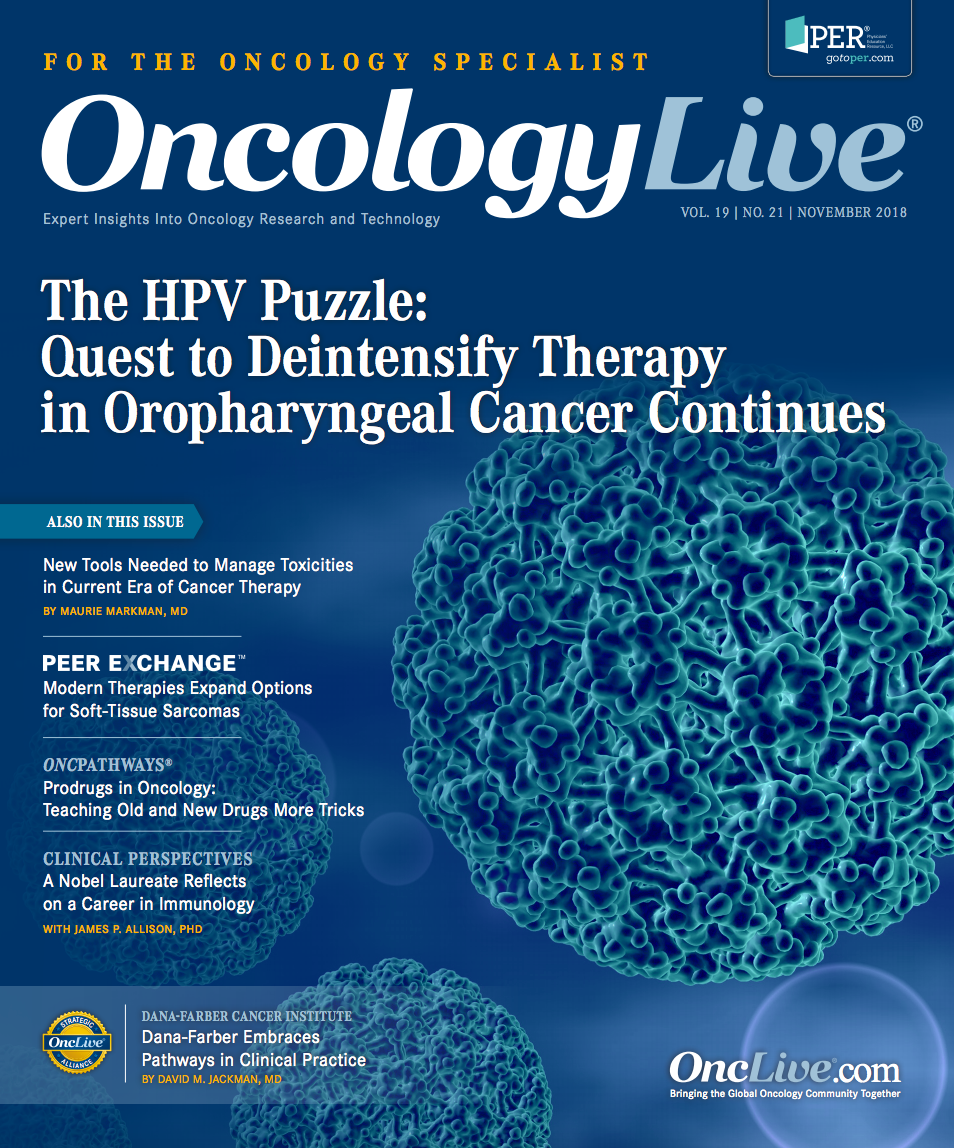Publication
Article
Oncology Live®
New Tools Needed to Manage Toxicities in Modern Era of Cancer Therapy
Author(s):
Maurie Markman, MD, discusses the search for less toxic strategies for the treatment of cancer that may lessen the negative impact on quality of life while maintaining therapeutic efficacy.
Maurie Markman, MD

Maurie Markman, MD
Much has been written and discussed over many decades on horrors associated with cytotoxic antineoplastic drug therapy. Of course, there is no official tally of the number of individual stories that have been told about this experience, but it is likely that the majority of adult members of our society can recite the ordeal of a family member or a friend regarding the seriously negative effects of anticancer treatment, ranging from neutropenic fever to bleeding due to low platelet counts, from hair loss to mouth sores, from nausea and vomiting to severe fatigue. These adverse events (AEs) can be distressing, debilitating, and even fatal.
As a result, the search for far less toxic strategies that could lessen the negative impact on quality of life while maintaining therapeutic efficacy has been an appropriate focus of considerable clinical investigation over the past several decades. During this period, various toxicity scales that focused on the acute AEs of antineoplastic cytotoxic therapy were developed and widely employed. These scales have taken into consideration the impact of bone marrow suppression, the development of intense nausea and vomiting, and the influence of therapy on highly susceptible rapidly dividing cells within the gastrointestinal tract that leads to mucositis and stomatitis.
Although chronic influences of treatment, such as congestive heart failure from anthracyclines and secondary acute leukemia from alkylating agents and radiation, were noted in these scales, the major focus of toxicity evaluation was on acute, severe, and potentially life-threatening AEs. This was a reasonable and quite pragmatic approach during this time because treatment of metastatic disease was generally of marginal utility and, therefore, delivered over limited intervals, and prevention of recurrence with adjuvant therapy was also designed only for short-term use.
Further, there was an advantage to evaluating toxicity in this era: It was possible to measure most AEs relatively easily and thus quantify their severity. Neutropenia, thrombocytopenia, and anemia are readily defined, as is severe emesis (the number of episodes of vomiting a patient experiences in the 24 hours following cytotoxic chemotherapy). Of course, this statement is not universally true; for example, fatigue has always been a highly complex and often poorly understood therapy-related event.
Chronic Disease Changes the Picture
Nevertheless, the focus on acute toxicity meant the specific events in question generally resolved or were greatly reduced in severity in an interval ranging from a few days (eg, emesis) to 1 or 2 weeks (eg, neutropenia and thrombocytopenia). This minimized the time and effort required to monitor and analyze the episodes.However, much has changed over the past 10-plus years in cancer management, specifically in the arena of patients with advanced or metastatic disease. Although many cancers are very serious and life-threatening, they are also considered to be chronic conditions for which therapy is delivered potentially for prolonged periods of time, sometimes measured in years. Not surprisingly, more chronic AEs are being observed, many of which develop slowly over an often-extended time frame (eg, peripheral neuropathy). In this setting, it is essential to question the clinical utility of existing antineoplastic toxicity scales that were developed to measure acute AEs of cytotoxic chemotherapy.
Further, and of considerable clinical relevance, what would likely be a reasonably acceptable AE that is classified as grade 1 if the toxicity lasted for 24 hours or less every 3 to 4 weeks—such as chemotherapy-associated nausea—may have a far greater negative impact on quality of life if it is experienced for this duration daily in a patient with cancer receiving an oral antineoplastic agent as a maintenance strategy for several years.
In fact, this is the specific question that must be asked regarding the paradigm-changing PARP inhibitors that the FDA recently approved as second-line or later maintenance therapy for patients with ovarian cancer.1 Although severe emesis is most uncommon with the use of any of the approved agents, 70% of patients overall were reported to experience low-grade emesis with the use of these drugs in phase III clinical trials.
So the questions to be asked are: Does a toxicity-monitoring system that classifies as “grade 1” the experience of daily mild nausea adequately capture the impact of that event on the quality of life of the individual patient? Is it reasonable to consider a modification in our toxicity scales to capture the realistic influence of this AE?
A second striking example of the need to more fully understand the impact of substantial differences in the AE profiles of antineoplastic therapy is the increasing use of immunotherapy and, specifically, checkpoint inhibitors in routine cancer care.2,3 Immunologically based AEs, some minor but others severe and life-threatening, represent a paradigm shift in disease management for the majority of practicing oncologists whose greatest experience has been associated with cytotoxic antineoplastic drugs.
The optimal approach to dealing with or preventing AEs following the delivery of these agents administered alone or as a component of a combination regimen requires new knowledge, greater experience, and the support of medical specialties uncommonly consulted in the past (eg, endocrinology) in routine cancer management. Plus, guidelines continue to evolve, prompting the need for constant physician education and updated familiarity about suggested changes in how to provide the best possible care.3
It is incumbent on the oncology research community to rapidly develop effective strategies to manage these new toxicities and to develop tools to appropriately measure and monitor their impact on the quality of life of patients with cancer.
References
- Markman M. Poly (ADP-ribose) polymerase inhibitors in the management of ovarian cancer. Womens Health (Lond). 2018;14:1-6. doi: 10.1177/1745505717750694.
- Postow MA, Sidlow R, Hellmann MD. Immune-related adverse events associated with immune checkpoint blockade. N Engl Med. 2018;(12)378:158-168. doi: 10.1056/NEJMra1703481.
- Brahmer JR, Lacchetti C, Schneider BJ, et al; National Comprehensive Cancer Network. Management of immune-related adverse events in patients treated with immune checkpoint inhibitor therapy: American Society of Clinical Oncology clinical practice guideline. J Clin Oncol. 2018;36(17):1714-1768. doi: 10.1200/JCO.2017.77.6385.





























%20(2)%201-Recovered-Recovered-Recovered-Recovered-Recovered-Recovered-Recovered-Recovered-Recovered-Recovered-Recovered-Recovered-Recovered-Recovered-Recovered-Recovered-Recovered.jpg?fit=crop&auto=format)
%20(2)%201-Recovered-Recovered-Recovered-Recovered-Recovered-Recovered-Recovered-Recovered-Recovered-Recovered-Recovered-Recovered-Recovered-Recovered-Recovered-Recovered-Recovered.jpg?fit=crop&auto=format)
